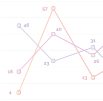INTRODUCTION
Nepal, officially the Federal Democratic Republic of Nepal, is a landlocked country in South Asia bordered by China in the North and India in the South, East, and West. Nepal comprises 7 provinces and 753 local bodies. It has a total population of 29,192,480. With a total area of 147,181 sq.km, Nepal has a diverse geography with landscapes ranging from fertile plains, subalpine forested hills, and the high Himalayas with eight of the world’s ten tallest mountains, including Mount Everest, the highest point on earth. Nepal is a multi-ethnic nation with Nepali as the official language.
DEMOGRAPHY
According to the Preliminary Report on Housing and Population Census 2021, the total population of Nepal is 29,192,480. Out of which, 14,291,311 (48.96%) of them are male and 14,901,169 (51.04%) of them are female. Data shows the increment in population by 10.18% which is 2,697,976 in a total as compared to Census 2011. The average annual population growth rate (exponential growth) in Nepal is 0.93%. Population density i.e. the average number of population per square kilometer is 198 per sq. km. The country has 5,643,945 households with an average household size of 4.32.
ECONOMY
In the fiscal year 2021/22, the Gross Domestic Product (GDP) is estimated to be at 4.85 trillion Nepali rupees. According to CBS projection, the Nepal’s economy is estimated to grow by 5.84% (annual growth rate of GDP at purchaser’s prices) in current fiscal year. Nepal’s economy is dominated by the tertiary sector, which estimated to contribute 61.8% to the current fiscal year’s GDP followed by the primary sector (24.5%) and the remaining 13.7% by the secondary sector. In fiscal year 2022/23, Nepal has allocated Rs. 1.79 trillion budget to implement policies and programs. Of the total allocation, Rs. 753.40 billion (42%) budget is allocated for recurrent expenditure, Rs. 380.38 billion (21.2%) for capital expenditure, Rs. 230.22 billion (12.8%) for financing and Rs. 429.83 billion (24%) for fiscal to provinces and local levels.
HUMAN DEVELOPMENT, POVERTY AND INEQUALITY
The three basic dimensions of human development are a) a long and healthy life b) access to knowledge and c) a decent standard living. In 2019, the human development index (HDI) score of Nepal is 0.587. It fall under the category of countries with a medium human development. The HDI score in urban areas is 0.647 whereas 0.561 in rural areas. According to Human Development Report of Nepal, Nepal’s overall loss due to inequality is 25.2% in 2019. Likewise, inequality in education and inequality in income is 23.7% and 31% respectively.
17.4% of the total population i.e. around 5 million population in Nepal are multi-dimensionally poor. The multidimensional poverty index (MPI) score is 0.074. Likewise, 67.3% of population in urban area are multi-dimensionally poor and MPI score is 0.053. The MPI score of rural areas is 0.119 and 32.7% of population are multi-dimensionally poor.
EDUCATION & HEALTH
In fiscal year 2021/22, there are 34,368 schools. Out of which, 26,454 of them are community schools, 6,760 of them are institutional schools and remaining 1,154 schools are religious schools. There were 280,765 teachers working in community and institution schools. Out of them, 61.02% are male and 38.98% are female. A total of 7,092,959 students were studying in school at different levels.
According to Annual Report 2020/21, there are 201 public hospitals, 189 primary health care centers (PHCCs), 3794 health posts and 2082 non-public facilities in Nepal. In fiscal year 2019/20, 84% of population utilized outpatient (OPD) services. However, it has decreased to 77% in fiscal year 2020/21. The average length of stay at hospital is 3 days.
USEFUL LINKS
Office of Prime Minister and Council of Ministers | https://www.opmcm.gov.np/
Ministry of Defense | https://mod.gov.np/en/home/
Ministry of Home Affairs | https://www.moha.gov.np/
Ministry of Communication and Information Technology | https://mocit.gov.np/
Ministry of Energy, Water Resources and Irrigation | https://moewri.gov.np/
Ministry of General Administration and Federal Administration | https://www.mofaga.gov.np/
Ministry of Finance | https://www.mof.gov.np/
Ministry of Water Supply | http://mows.gov.np
Ministry of Foreign Affairs | https://www.mofa.gov.np/
Ministry of Agriculture and Livestock Development | http://moald.gov.np/
Ministry of Physical Infrastructure and Transport | http://mopit.gov.np/
Ministry of Industry, Commerce and Supplies | https://moics.gov.np/en
Ministry of Education, Science and Technology | http://moestys.gov.np/
Ministry of Women, Children and Senior Citizen | https://mowcsc.gov.np/
Ministry of Land Management, Cooperative and Poverty Alleviation | https://molcpa.gov.np/home
Ministry of Youth and Sports | https://www.moys.gov.np/en
Ministry of Law, Justice and Parliamentary Affairs | http://www.moljpa.gov.np/en/
Ministry of Culture, Tourism and Civil Aviation | https://www.tourism.gov.np/
Ministry of Urban Development | https://www.moud.gov.np/
Ministry of Health and Population | https://mohp.gov.np/en
Ministry of Labour, Employment and Social Security | https://moless.gov.np/
Ministry of Forest and Environment | http://mofe.gov.np/
REFRENCES
Central Bureau of Statistics. (2022). Preliminary Report on National Population and Housing Census 2021. Kathmandu, Nepal; Central Bureau of Statistics. Retrieved on July 28, 2022 from: https://bit.ly/3zGAkzx
Central Bureau of Statistics. (2022). Excel – National Accounts Statistics of Nepal (2021/22 Annual Estimates). Kathmandu, Nepal; Central Bureau of Statistics. Retrieved on August 1, 2022 from: https://bit.ly/3OPnzIr
Ministry of Finance. (2022). Budget Speech of the Fiscal Year 2022/23. Kathmandu, Nepal; Ministry of Finance. Retrieved on August 1, 2022 from: https://bit.ly/3QcUxDl
National Planning Commission and United Nations Development Programme. (2020). Nepal Human Development Report 2020 – Beyond Graduation: Productive Transformation and Prosperity. Kathmandu, Nepal; National Planning Commission and United Nations Development Programme. Retrieved on August 1, 2022 from: https://bit.ly/3POaf8v
National Planning Commission. (2021). Nepal Multidimensional Index: Analysis towards Action 2021.Kathmandu, Nepal; National Planning Commission. Retrieved on August 1, 2022 from: https://bit.ly/3vxfXTX
Ministry of Finance. (2022). Economic Survey 2021/22. Kathmandu, Nepal; Ministry of Finance. Retrieved on August 1, 2022 from: https://bit.ly/3zmjVA2
Department of Health Services. (2022). Annual Report, 2077/78 (2020/21). Kathmandu, Nepal; Department of Health Services. Retrieved on August 1, 2022 from: https://bit.ly/3OSFQ7s

